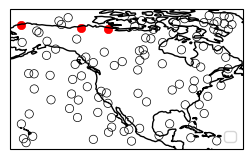Active learning#
DeepSensor allows you to perform active learning with your models to propose new context locations that are expected to improve the model’s predictions. This functionality is based on the study ‘Environmental sensor placement with convolutional Gaussian neural processes’ (EDS, 2023), which may be helpful background reading.
The core active learning classes in DeepSensor are the AcquisitionFunction and its children, which assign a utility value to query locations,
and the GreedyAlgorithm, which greedily optimises an AcquisitionFunction to propose new context locations.
What does ‘greedy’ mean?
The term ‘greedy’ comes from the active learning literature and simply means that the algorithm iteratively optimises one sensor placement at a time, rather jointly optimising all \(N\) placements simultaneously. This breaks the overall optimisation problem down into smaller, lower-dimensional problems.
This page will use the pre-trained ERA5 spatial interpolation ConvNP from the previous Training page and use DeepSensor’s active learning functionality to propose new context locations based on some random initial context locations.
task_loader = TaskLoader(
context=[era5_ds, land_mask_ds, lowres_aux_ds],
target=era5_ds,
)
task_loader.load_dask()
print(task_loader)
TaskLoader(3 context sets, 1 target sets)
Context variable IDs: (('2m_temperature',), ('GLDAS_mask',), ('elevation', 'cos_D', 'sin_D'))
Target variable IDs: (('2m_temperature',),)
set_gpu_default_device()
# Load model
model = ConvNP(data_processor, task_loader, deepsensor_folder)
Initialising a GreedyAlgorithm#
The GreedyAlgorithm class searches over a set of query context locations, evaluating
an AcquisitionFunction at each query location, adding a context point at that location, and repeating until
N_new_context points have been added, returning the proposed context locations as a pandas.DataFrame
and the acquisition function values in a xarray.Dataset.
from deepsensor.active_learning import GreedyAlgorithm
alg = GreedyAlgorithm(
model,
X_s=era5_raw_ds,
X_t=era5_raw_ds,
X_s_mask=land_mask_raw_ds,
X_t_mask=land_mask_raw_ds,
context_set_idx=0,
target_set_idx=0,
N_new_context=3,
progress_bar=True,
)
Initialising an AcquisitionFunction#
There are various acquisition functions provided in the deepsensor.active_learning.acquisition_fns module.
Here we will demonstrate one simple acquisition function, Stddev, which returns the standard deviation of the model’s predictions at each query location.
This can be used to find locations where the model is most uncertain.
For an up-to-date list of acquisition functions see the API documentation for the deepsensor.active_learning.acquisition_fns module.
If an acquisition function is missing, you can easily implement your own by subclassing AcquisitionFunction and implementing the __call__ method.
from deepsensor.active_learning.acquisition_fns import Stddev
acquisition_fn = Stddev(model, context_set_idx=0, target_set_idx=0)
Calling a GreedyAlgorithm#
Calling a GreedyAlgorithm requires a Task (or list of Tasks) containing context data, and an AcquisitionFunction.
If a list of Tasks are provided, it’s assumed they correspond to different dates,
and the acquisition function will be averaged over time when finding the best query location.
When the GreedyAlgorithm finishes the search process, it returns a pandas.DataFrame containing proposed placement locations and an xarray.Dataset containing acquisition function values for each time and placement iteration.
val_dates = pd.date_range(val_range[0], val_range[1])[::date_subsample_factor]
placement_dates = val_dates
placement_tasks = task_loader(placement_dates, context_sampling=[100, "all", "all"], seed_override=0)
X_new_df, acquisition_fn_ds = alg(acquisition_fn, placement_tasks)
100%|██████████████████████████████████████████████████████████████████| 549/549 [00:31<00:00, 17.69it/s]
X_new_df
| x1 | x2 | |
|---|---|---|
| iteration | ||
| 0 | 68.50 | -118.75 |
| 1 | 70.25 | -159.75 |
| 2 | 69.00 | -131.25 |
fig = deepsensor.plot.placements(placement_tasks[0], X_new_df, data_processor,
crs=ccrs.PlateCarree())
No artists with labels found to put in legend. Note that artists whose label start with an underscore are ignored when legend() is called with no argument.

fig = deepsensor.plot.acquisition_fn(
placement_tasks[0], acquisition_fn_ds, X_new_df,
data_processor, crs=ccrs.PlateCarree(), add_colorbar=False,
cmap="Greys")
Averaging acquisition function over dims for plotting: ['time']
No artists with labels found to put in legend. Note that artists whose label start with an underscore are ignored when legend() is called with no argument.

